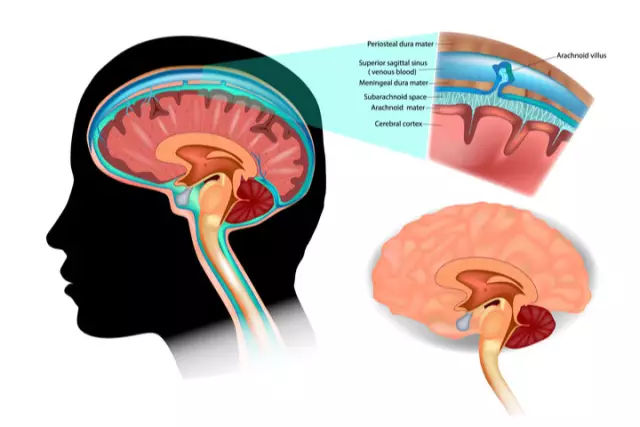- Author Curtis Blomfield [email protected].
- Public 2023-12-16 20:44.
- Last modified 2025-01-23 17:01.
Cerebrospinal fluid (another name is CSF) is a specific fluid that is in close relationship with the spinal cord and brain. It is produced by the plexuses of the vessels of the brain. In 24 hours, about 400-600 milliliters of cerebrospinal fluid are produced. In the presence of any pathology - up to 1000. Cerebrospinal fluid is completely renewed from 6 to 8 times per day. In addition to cerebrospinal fluid, the membranes of the brain and spinal cord play an important role in the nervous system.

Cerebrospinal Fluid Functions
1. Protective. Forms a water cushion that protects the spinal cord and brain from concussion, pressure changes, compression and other negative mechanical effects.
2. Cerebrospinal fluid is a source of nutrition that is needed for the growth of the cell mass of the brain. And even in the postnatal period, this fluidplays an important role in the processes of metabolism of nervous tissue. The cerebrospinal fluid, filling the pericellular and perivascular spaces, comes into contact with the cells of the nervous system. Then it absorbs metabolic products and gives the cells the substances necessary for their functioning.3. Regulation of osmotic pressure, maintaining its constant value in the brain tissues.

Amount of CSF:
- in newborns - from 30 to 60 milliliters;
- in children older than three years - from 100 to 150 milliliters (with about 50 percent of the cerebrospinal fluid is in the ventricles of the brain, 30-40 percent - in the tanks of the brain of the head and in the subarachnoid spaces, the rest of the cerebrospinal fluid - in the spaces of the subarachnoid spinal brain).
CSF contains hormones, vitamins, inorganic and organic compounds.
In young children, the study of cerebrospinal fluid plays a special role, since at this age there are often various disorders that were caused by birth trauma or asphyxia, and some inflammatory diseases have similar symptoms. Cerebrospinal fluid is examined for meningoencephalitis, meningitis, asphyxia, convulsions, volume processes, hydrocephalus, hereditary diseases and before the introduction of contrasts into the spinal canal (ventriculography).

CSF is obtained by ventricular or lumbar puncture. In young children, lumbar puncture is performed in the supine position.position (approximately 2 hours after eating). The patient must be laid on his side, bend his legs to the stomach in order to increase the distance between the vertebrae. After that, the skin is treated and a puncture is made. The cerebrospinal fluid is collected in a special sterile tube. After taking the fluid, the needle is removed. The puncture site is carefully lubricated with iodine and a bandage is applied. Then the patient is placed on the bed in a horizontal position, without a pillow. Feeding is allowed after about two hours. Within two days, the patient should observe bed rest and try not to make sudden movements of the head. Also, after the puncture, it is not recommended to use various physiotherapeutic procedures (gymnastics, exercise therapy, massage).






